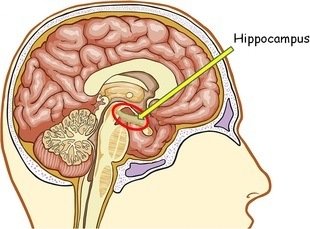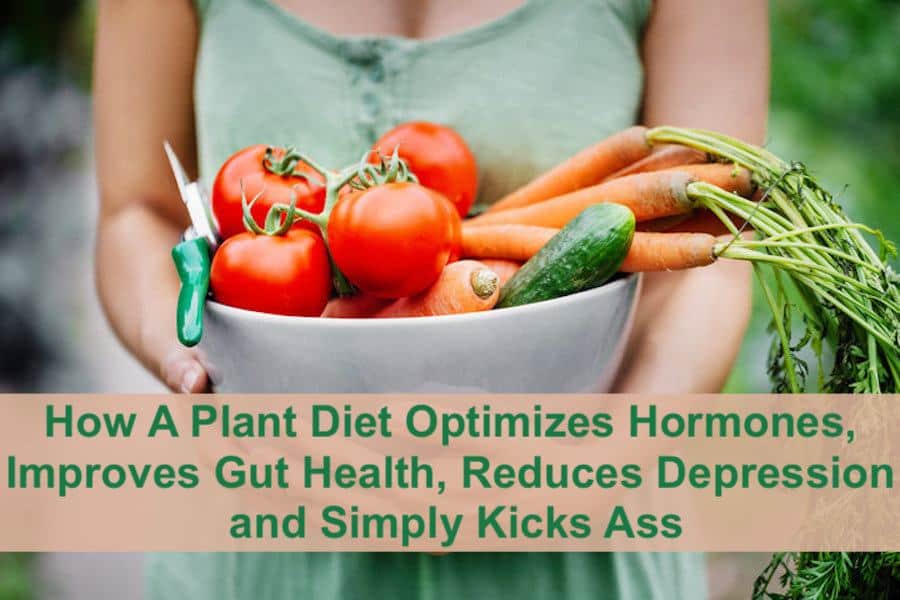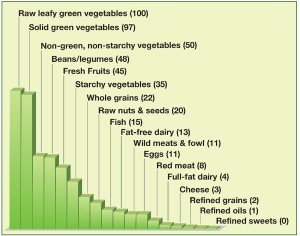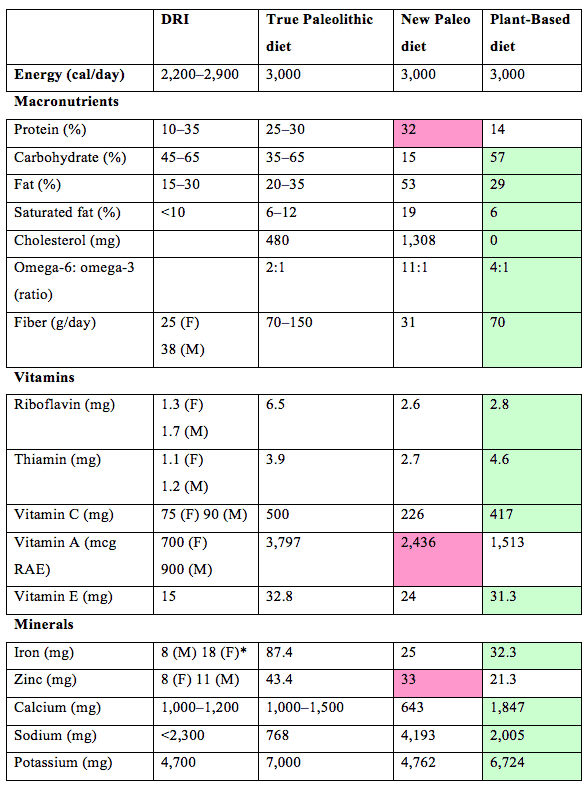How A Plant Diet Optimizes Hormones, Improves Gut Health, Reduces Depression and Simply Kicks Ass
It’s not complicated — the best diet is a plant diet; meaning a diet with with the most plant foods. Eat some meat, eat some diary, eat some grains, but focus on eating plants every day and your health will thrive.
PLANTS, plants, plants — if you want less depression in your life, better hormone health, better gut health, than eat more of what grows in dirt.
Eat a plant diet.
Eat less of anything that once had a face (except low-mercury fish), sugary foods, fast foods and manufactured foods (like most breakfast cereals and many packaged foods).
Extra credit: decrease your “feeding window” to 12 hours or less, making sure that nothing enters your mouth after 8:00 PM except perhaps herbal tea, apple cider vinegar or pure water.
That’s it in a nutshell.
Those of you disinterested in specifics now have the knowledge you need to live long and strong, bereft of the many chronic diseases associated with aging, such as heart disease, diabetes, debilitating osteoarthritis and obesity.
Those of you who want to know the reasons why my assertions are true, and get some tips, read on.
In this article, you’ll discover:
- The most nutritionally dense food group
- Why Paleo is closer to Veganism than you’d ever imagine
- If the Keto diet is for you
- What to eat for hormonal health
- Why the DASH diet reduces depression
- How fiber reduces blood sugar
- Why Grandma was right (just ask a gorilla)
- Your 5 new ways of eating
Let’s dig in…
ANDI and NuVal — It’s About the Density of a Plant Diet
Nutritional density, that is, and quality — the two things that the ANDI and NuVal indices score.
The highest nutritionally dense and high quality foods happen to also be plant-based foods. Here a medical doctor and a research-oriented billionaire show you the best foods on the planet for vibrant health and longevity, as depicted by this bar chart:
The bar chart is depicting the ANDI score for various foods. “ANDI” is the acronym for “Aggregate Nutrient Density Index”, which is the numerical measurement of the nutritional density of food, including its vitamin, mineral, antioxidant, and phytochemical composition.
The index was developed by Dr. Joel Fuhrman of Eat Right America, but he’s not the only doctor with a food quality index. Dr. David Katz has one as well, called NuVal.
NuVal is not a diet, but a way of determining if the food in yours is worth eating; it’s a system of assigning a single numeric value to determine foods’ worth, as opposed to what some consider is a complex nutritional label placed on the packaging of most foods that many consumers don’t sufficiently understand.
I bumped into Dr. Katz and NuVal when researching material for my article, Your Very Best Diet Verified By Science.
A few years ago, he and his research partner, Stephanie Meller, set out to review the research and discover the most healthy diet. They wound up comparing these diets:
- Low carb
- Low fat
- Low glycemic
- Mediterranean
- Paleolithic
- Vegan
The diets are represented in this table:
Here’s their big takeaway:
“A diet of minimally processed foods close to nature, predominantly plants, is decisively associated with health promotion and disease prevention and is consistent with the salient components of seemingly distinct dietary approaches”. (Source)
To reiterate — the two characteristic a healthy diet it must have are:
- The food has not been adulterated (processed), and
- It’s full of plants; aka, a plant diet.
And, given that plants are nutritionally dense, they provide you with two major benefits:
1. Your body gets the best fuel for growth, energy and repair, and
2. You get fuller with fewer calories.
Smart Tips
What About Paleo?
Yes, surely it’s been popular over the last decade or so, and many people swear to its effectiveness. Just like vegans do about their diet of choice.
It’s been amusing to me to observe the combat engaged between what appears to be two totally different conceptions of what constitutes a healthy diet.
Appears to be?
Well, yes, they are different, but not as much as you might think.
“Paleo” gets its name from the “paleolithic” period, denoting the early phase of the Stone Age. Back then, Paleo diehards assert, your food choices were meat, eggs, nuts, vegetables and fruit; perhaps a few other stray items, but certainly NOT grains, beans, legumes and dairy, or any processed foods.
Furthermore, say Paleo diet adherents, because humans evolved with the foods available during the Paleo period, there the most natural for our constitution and the best foods for us to consume.
Shocker Alert!
As I explored in Make Your Paleo Diet More Vegan, Like It Used To Be, nutritional anthropologists have been estimating the nutrient intakes of our friendly cave-dwelling forefathers for several decades. They’ve discovered something so shocking that it could knock the legs from under the biggest, meanest, Mastodon thigh-bone-chewing Paleolithic wannabe thumping his chest with Chris Kresser’s paleo book.
The shocker?
Well, wipe the grease off your chin and stare in disbelief at the following table, which shows that Vegan diets may actually come closer to matching the macro and micronutrient intakes of Paleolithic diets than do new Paleo diets!
Before you throw a mastodon’s thigh bone at me, consider a very carefully conducted study that  compares these three food menus:
compares these three food menus:
- Recommended Paleo menus,
- Recommended plant-based menus, and
- A true Paleolithic diet eaten by early humans.
The table below summarizes the results.
The dietary reference intakes (DRIs) are for adult males (M) and adult females (F) who aren’t pregnant or lactating. Nutrients and other dietary factors in the new Paleo or vegan diet that are more similar to the true Paleolithic diet are highlighted (pink for the new Paleo diet and green for the vegan diet).
True Paleolithic, New Paleolithic, and Plant-based Diets Compared (source)
Here’s a summary of what the comparison shows:
- When it comes to protein, vitamin A, and zinc, the recommended new Paleo menu and the true Paleoithic diet are more closely aligned than the plant-based vegan menu.
- Fat and saturated fat levels of the new Paleo menu are nearly double, cholesterol almost triple, and sodium five times as much as the true Paleolithic diets.
- Carbs are a third less, and vitamin C, calcium and fiber consumed in the new paleo menu are half that of true Paleolithic diets.
- Fiber consumed by our pre-agricultural ancestors is, at worst, equal to the 100% plant-based menu, and as much as double it, far exceeding the new Paleo menu.
- Intakes of carbohydrate, fat, saturated fat, fiber, riboflavin, thiamin, vitamin C, vitamin E, iron, calcium, sodium, and potassium are closer between a true Paleolithic diet and vegan menu than to the new Paleo menus.
If you eat Paleo or are intrigued by the notion, read this article I wrote, particularly my conclusion.
Smart Tips
What About Keto?
It’s the rage.
Several of my friends are on the Keto diet. My mother wants to do it. Some really smart doctors, like Dr. Andreas Eenfeldt (aka, the Diet Doctor) and Dr. Peter Attia recommend it.
So, should you try the Keto diet?
Simply put, I dunno.
But given what I’ve read about the Keto diet, there’s a few things you should know about before you try it, such as:
- The initial weight people lose is often water weight,
- It might not be healthy long-term,
- It’s not about just eating mostly any kind of fat and little else,
- You can’t eat as much protein as, say, Paleo,
- You still need to eat plants, and
- Many who think they’re doing the Keto diet do not actually get into ketosis.
So, what is ketosis, you ask?
“Ketosis is a normal metabolic process, something your body does to keep working. When it doesn’t have enough carbohydrates from food for your cells to burn for energy, it burns fat instead. As part of this process, it makes ketones.”
And, as WebMD defines it:
Ketones are chemicals made by your liver that you produce when you don’t have enough of the hormone insulin in your body to turn sugar (or “glucose”) into energy. You need another source, so your body uses fat instead.
Which leaves us with the question embedded in this picture:
Yep, that’s the one single article I’ve written (so far) about the Keto diet. I suggest you give it a look if you’re considering trying this diet.
Here’s what I covered in Is The High Fat Keto Diet For You? One Woman and Three Experts Tell The Tale.:
- What is a “ketogenic diet”
- The pluses and minuses
- Melia Robinson’s experiment seeking ketosis
- The advice she got from keto diet expert, Dr. Priyanka Wali
- Melia’s results after two months on the keto diet
- A deep dive into the science via Dr. Rhonda Patrick’s interview with keto expert Dr. Dom D’Agostino
If you do the Keto diet, make sure you regularly test if you’re in ketosis by using something like the Precision Xtra Glucose Meter Kit (which also measures ketones) and a 10-pack of ketone testing strips.
Smart Tips
What to Eat for Hormonal Health?
Yes, plants once again… we’re still talking about a plant diet.
Lauren Brown West-Rosenthal reports that Magdalena Wszelaki, author of Cooking for Hormone Balance identifies five foods that support healthy hormone levels — mainly focused on women, but I’m going to sneak in one for men.
As a certified holistic health coach, Ms. Wszelaki healed herself from multiple maladies, including autoimmune disorders, adrenal fatigue, and estrogen dominance. Her advice begins with what you should delete, before adding the five foods for hormonal health.
Clear your pantry of these four foods:
- Inflammatory processed foods
- High-sugar snacks
- Meat from conventionally raised animals that have been injected with antibiotics and growth hormones
- Dairy from conventionally raised animals that have been injected with antibiotics and growth hormones
Now add these foods:
1. Flaxseed
Best known for its omega-3 content, flaxseed also contains lignans—a form of phytoestrogens that can bind to estrogen receptors in the human body and thereby reduce excess estrogen that can cause health issues such as PMS, fibroids, breast lumps, fibrocystic breasts, estrogen-positive breast cancer, and flabby chests on men.
Flaxseed can also help with elimination, which is a critical aspect of hormone balance. “Flax is high in soluble fiber, which is a great prebiotic, and insoluble fiber. Fiber is important to help ensure regular bowl movements and detoxing us from ‘used up’ hormones,” explains Wszelaki. “I recommend adding two tablespoons daily of freshly ground golden flaxseed to any meal, but keeping the seeds unheated.” The easiest way to get your fix: Throw ’em into a smoothie as I describe in Smart Tip above.
2. Crucerferous Veggies
Load up on veggies such as broccoli, cabbage, cauliflower and kale. “They contain a compound called diindolylmethane (DIM), which supports healthy levels of estrogens,” says Wszelaki. “DIM [may help] with conditions such as endometriosis, PMS, breast lumps, and breast cancer.” She recommends eating three to five lightly cooked servings of cruciferous veggies per day.
You can also take a 200 mg/day DIM supplement, but Wszelaki cautions against using this as a quick fix. “Diet is the foundation and first step in rebalancing our hormones,” she says.
3. Bitter Greens
The nutrition in romaine lettuce pales in comparison to arugula, watercress, or dandelion greens, do swap it out for these. They provide nutrients necessary for hormone production while stimulating good digestion to flush excess hormones from the body. “I recommend regularly adding dandelion leaves to salads or stir fries,” says Wszelaki.
One caveat: Dandelion greens, in particular, are an acquired taste (to say the least.) Consider trying them first in a quinoa or farro salad before making them the main event in a dish.
4. Broccoli Sprouts
Broccoli sprouts are a medicinal powerhouse due to their high sulphoraphane content—a powerful antioxidant with anticancer properties that also supports detoxification of the liver and, subsequently, excretion of excess hormones. “For preventive purposes, I recommend adding 1/4 cup per day to smoothies or salads—and the sprouts need to remain raw,” says Wszelaki. “For women with estrogen-positive breast cancers, the dose should be one cup per day.”
5. Sea Veggies
Seaweed, kelp, wakame, and dulse are rich in B vitamins, which are critical for hormone balance and support breast health. (The only people who shouldn’t eat iodine-rich seaweeds, according to Wszelaki are Hashimoto’s patients with elevated antibodies.) Wszelaki: “My recommendation is to add kelp when simmering soups and stews. Rehydrated wakame and dulse can be tossed into salads and soups. Just a couple of tablespoons per week will produce great results.”
 [6.] Aggressive Strength Testosterone Booster
[6.] Aggressive Strength Testosterone Booster
This one I’m adding to the mix, and it’s for men. No, it’s not a food group, but rather a testosterone-boosting supplement consisting of various herbs.
I can tell you from personal experience that Aggressive Strength Testosterone Booster is very likely to increase your testosterone, and thereby elevate your mood, give you more energy and help you add lean muscle, should you be doing any resistance training.
If you’re interested in testosterone-boosting supplements, read my article,
8 Testosterone Enhancing Supplements (and 2 drugs) That Will Keep You From Turning Into A Girl.
DASH — A Plant Diet For Depression?
As the 19th century French lawyer Jean Anthelme Brillat-Savarin wrote, in 1825,
“Dis-moi ce que tu manges, je te dirai ce que tu es.”
Translation: “Tell me what you eat, and I will tell you what you are.”
Mr. Brillat-Svarin, are you suggesting that the consumption of certain foods can somehow make us less depressed?
Olga Khazan, a staff writer at The Atlantic addresses that question in her article, The Diet That Might Cure Depression, where she says,
“Several studies show that healthy eating is connected with better mood,” and that a poor diet is a leading risk factor for early death, responsible for one in five deaths globally.
I need to pause here for a bit so you can let that sink in:
20% of deaths worldwide are due to diet!
OK, that’s depressing, so what about that?
Depression is the leading cause of disability worldwide.
So, maybe you can reduce your risk of dying by being more selective about what you eat, but then depression is going to bring your to your knees?
Actually, probably not, because the same thing that will make it more unlikely that you die will also make it more unlikely that you’ll be depressed, because the solution to both is the same thing — Plants!
Not just plants. Other foodstuff too. Let me explain, beginning with the DASH diet.
The DASH diet was developed by the U.S. National Heart, Lung, and Blood Institute. It’s not extraordinary. A typical DASH dinner consists of a lean meat, baked potato, and lots of vegetables.
Researchers wonder why it’s so beneficial. The thinking is that the reason is because the DASH diet is a “plant-heavy diet”, and as such the fiber from the plant matter ferments in the gut and creates short-chain fatty acids (SCFAs), which, in turn, regulate the immune system and influence gene expression in the brain and elsewhere. People who eat fiber have more diverse gut bacteria, and these bacteria make various chemicals that influence our mood.
Yes, we’re back to the gut.
Regular readers know that I’m a bit nutty about the microbiome — that environment made up of the tens of trillion of microbes on and in us, particularly our guts — and thus have written in depth about it.
I’ll zig zag back to this in a moment, but first let’s finish up with DASH and its effect on SCFAs, immunity and gene expression in the brain, et al.
Inflammatory molecules, called cytokines, are produced by body fat and can spark systemic inflammation in the body. Inflammation increases the risk of depression and other diseases by harming the lining of the blood vessels.
Meanwhile, healthy fats like SCFAs increase the production of proteins called neurotrophins, which  “act like manure to the brain as they promote the growth of new brain cells in the hippocampus,” says Dr. Felice Jacka in Olga Khazan article:
“act like manure to the brain as they promote the growth of new brain cells in the hippocampus,” says Dr. Felice Jacka in Olga Khazan article:
“There is a strong link between the quality of people’s diets and the size of their hippocampus,” which by the way is one of the first parts of the brain to suffer damage from Alzheimer’s.
John Cryan, an expert in the gut-brain connection at University College Cork in Ireland, says these studies point to the growing recognition of the importance of diet—along with the other old standbys, exercise and sleep—in regulating mood. In fact, despite feeling cautious about the early nature of this line of research, he says he would recommend depressed people try eating better to see if it helps.
Of course doing anything useful for yourself while depressed is a big challenge, particularly changing how you eat, but let’s not get depressed about it.
Smart Tip
Dietary Fiber and Blood Sugar
Now I’m zig zagging back to the gut.
In the section above about the DASH diet’s beneficial effects on reducing depression, we learned that, in part, this happens because dietary fiber helps create more diverse gut bacteria, and these bacteria make various chemicals that influence our mood.
But such beneficial bacteria do a lot more than that.
In this Forbes article, Julia Olayanju, the Founder of FoodNiche interviewed Dr. Liping Zhao, the Eveleigh-Fenton Chair Professor of Applied Microbiology at Rutgers University. He is a world-renowned scientist who has spent almost 2 decades studying the gut microbiota and gut health, and recently pioneered a study showing that high dietary fiber promote gut bacteria is beneficial to blood sugar control.
Among the many questions and answers conducted in Ms. Olayanju’s interview, I want to bring your attention to this exchange, because it underscores the importance of dietary fiber on promoting colonies of beneficial bacteria in our guts, which then improves, in this example, blood sugar outcomes, but also is important for our psychological well being.
I’ve edited the following exchange:
Julia Olayanju: You recently discovered that high dietary fiber plays a role in Type 2 diabetes management or treatment, can you discuss what you did specifically?
Liping Zhao: Yes, we investigated the effects of a high fiber intervention on blood glucose and metabolic health in patients with type 2 diabetes. There were two groups: those getting treatment and the those not (control group).
The control group received standard patient education and dietary recommendations. The treatment group was provided with a diet similar in energy and macronutrients to the controls, plus a large amount of dietary fibers with diverse structures and properties.
Over 12-weeks, the treatment group experienced more significant and faster improvement in blood glucose control, greater weight loss, and better lipid profile compared to the controls. Importantly, the study showed that these beneficial effects of the high fiber diet were directly contributed by changes in the gut microbiota.
We further identified a small group of bacterial strains that were likely to be the key drivers of patients’ clinical improvements: these bacteria all possess the ability to produce SCFAs, (short chain fatty acids) and by taking advantage of the increased dietary fibers, they out-competed the others and became dominant members of the gut microbial community.
Intrigued by fiber?
Read my article, A High-Fiber Diet + 8 Easy Fat-Busting Tips You Can Do Now.
The types of fiber mentioned in the exchange above between Dr. Zaho and Julia Olayanju can be found here (scroll down to “Definitions of Fiber”), and include:
The links above for inulin, pectin, resistant starch and psyillium are for products on Amazon.com. Taking these as powdered supplements takes the effort out of ensuring you get enough of these beneficial fibers; however, they are found in whole foods as well.
Want to test your microbiome?
Smart Tip
Grandma Was Right
Are you still with me?
And just how confused are you at this point?
Remember how we started — It’s all about eating more plants, or as Grandma used to say,
Eat your veggies.
Or as I like to say,
Let’s watch world renown nutritional expert Dr. Michael Greger dumb it down for us in this quick video:
Smart Tip
Your New Way of Eating
Try these five things:
(1) Eat More Plants
As I’ve been saying, eat more plants. That consists of vegetables of every stripe and color, greens and legumes (beans, lentils and the like).
Don’t be concerned about the stories of those ant-nutrients (lectins and phytates) in legumes. If you are concerned about them, you can pretty much obliterate them by pressure cooking or soaking your legumes overnight, or sprouting them a bit (but not too much sprouting or you’ll get a plant not a legume).
When you look at your plate, make sure that there’s more plant-stuff in it than anything else. In the context of this article, a plant diet isn’t exclusively made up of plants, but is dominated by them.
(2) Reduce Your Feeding Window
Do this gradually.
Five to six days a week, I practice Intermittent Fasting. In my case, I stop eating by 8:00 PM and don’t eat again till 1:00 PM the next day. If that sounds tough, remember that I’m sleeping for eight of those hours.
You can try 12 hours at first, say pushing the pause button on eating from 8:00 PM to 8:00 AM the next morning. Once that becomes habitual, extend it another hour, but don’t go nuts on this, as 16 hours of this “intermittent fast” is plenty. Even at 12 hours, you will already be getting major benefits due to cellular autophagy.
Read my article, How Intermittent Fasting Ignites Cellular Autophagy and A Longer, Healthier Life.
If you do nothing else with respect to when you eat, stop eating as early in the evening as you can.
As Dr. Satchidananda Panda is fond of saying,
“When you eat is more important than what you eat.”
Dr. Satchidananda Panda is the Professor of Regulatory Biology Laboratory a the Salk Institute where he studies the genes, molecules and cells that keep the whole body on the same circadian clock.
He and his colleagues have made these three remarkable discoveries:
- That confining caloric consumption to an 8- to 12-hour period –- as people did just a century ago -– might stave off high cholesterol, diabetes and obesity. He is exploring whether the benefits of time-restricted eating apply to humans as well as mice.
- That a single gene that can simultaneously reset all the cells in the SCN*. Mice with the lowest levels of the gene recovered the fastest from a simulated time zone change. The finding suggests a new target for treating jet lag or sleep disorders.
- That a pair of genes help keep eating schedules in sync with daily sleep cycles, making you feel hungry for meals at the same time every day. Mutations in these genes could explain night eating syndrome.
It’s all about getting aligned with our circadian rhythms, as I explain here.
If you’re intrigued about the power that Intermittent Fasting and circadian rhythms have over your health, read Why Intermittent Energy Restriction and Circadian Rhythms Optimize Your Health.
(3) Reduce Your Consumption of Sugary Carbs
I’m referring to carbs that act like sugar, and when consumed spike your blood glucose levels. Sometimes such carbs are referred to as “fast carbs” (they’re quickly spike blood glucose levels), “simple carbs” (fiber has been eliminated) or high-glycemic carbs (an index indicating how a particular carbohydrate source compares to sugar relative to blood sugar/glucose uptake once ingested).
It need not be complicated. Just try to do this:
- If you eat grains, make sure they’re whole, not refined.
- If you like fruit, consume fruit — not fruit juice — and eat a mix of fruit, not just bananas.
- Eat as many veggies as you want; yes, they’re carbs, but are absorbed slowly, are nutritious and contain fiber.
- When you eat sugary carbs, also eat protein and a quality fat, like nuts or an avocado, to minimize the blood sugar spike.
(4) Eat More Omega 3 Fatty Acids
As I wrote in How To Get Lean and Muscular, Part 3 — Fuel Your Body, there are lots of different types of fat, but the one I want to focus on is the type of fat this both essential, healthy and very underrepresented in the American diet — omega-3 fatty acids.
Harvard’s School of Public Health informs us that the human body can make most of the types of fats it needs from other fats or raw materials. That isn’t the case for omega-3 fatty acids, because these essential fats can not be made from the body from scratch, but must be sourced from food.
What makes omega-3 fats special?
They are an integral part of cell membranes throughout the body and affect the function of the cell receptors in these membranes. They provide the starting point for making hormones that regulate blood clotting, contraction and relaxation of artery walls, and inflammation. They also bind to receptors in cells that regulate genetic function. Likely due to these effects, omega-3 fats have been shown to help prevent heart disease and stroke, may help control lupus, eczema, and rheumatoid arthritis, and may play protective roles in cancer and other conditions.
Livestrong tells us that the omega-3 fatty acid in fish oils can have fat burning benefits and can also cause your body to reduce the amount of body fat it stores. According to AminoAcidStudies.com, fatty acids can aid in the breakdown of fat while simultaneously reducing additional fat storage. As the list below shows, fish rich in omega-3 include mackerel, halibut and salmon.
Here’s a list of some foods containing omega-3 fatty acids:
- Hemp seeds
- Flaxseeds
- Chia seeds
- Fish oil
- Salmon
- Halibut
- Mackerel
- Sardines
- Herring
- Walnuts
- Avocado
For more omega-3 choices, check out the Nutrition Data website.
(5) Drink More Pure Water
You’d think that this one would be the easiest to do, yet it’s my biggest challenge.
Some say that you can include the various healthy beverages you consume in your tally for daily water consumption. By that measure perhaps all the herbal tea contributes more than I’m willing to accept. Nonetheless, I need to drink more water, and you might too.
Besides hydration, water can:
- Make you feel more full, so you’re less likely to overeat,
- Assist your kidneys in their detoxification role, and
- Help keep your skin looking youthful and plump.
Smart Tips
Your Takeaway
Do these nine things to gradually bring you to a plant diet, focusing on one at a time until it become habitual:
- Eat food that looks like it just came off the farm, basically.
- Eat very little of the carbs that boost blood sugar, which means you need to get a sense for their glycemic load and index. Simple clue – the more processed, the higher the index.
- Eat healthy fats – more vegetable fatty acids than diary and meat, and increase those derived from omega-3 fatty acids.
- If you eat meat, get it from animals raised on grassy pastures. Yes, it’s more expensive, so eat less of it.
- By volume, eat more veggies than any other single food source.
- Drink more pure water – most of us drink too little of it.
- Reduce your feeding window.
- Eat in balance with your circadian rhythms, which means don’t eat after 8:00 PM.
- Review each of the Smart Tips above and do them.
As with all things, tackle all this with a light heart.
P.S. Read my Diet 101.
P.P.S Check out these guidelines from RealFoodCentral.com
Last Updated on February 25, 2024 by Joe Garma












